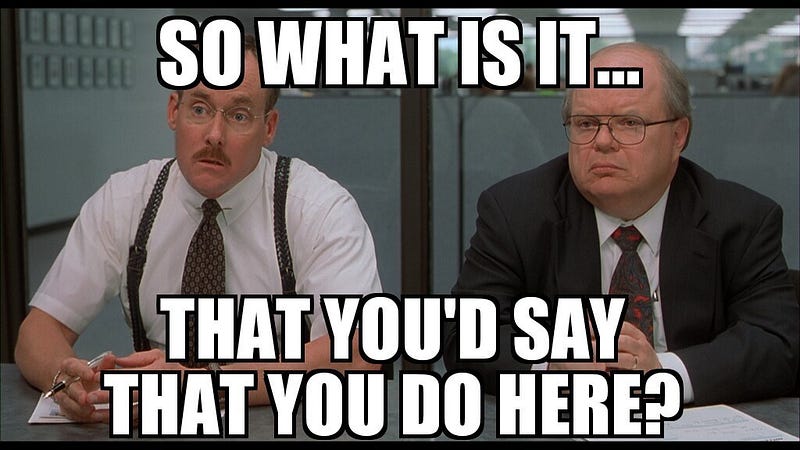Introducing the UOCT

Here’s something you’ve never heard of before (because I just made it up). UOCT is pronounced “You-Oct” and it stands for Unconference OfficeHours Collaboration Time. But before we get into that I want to explain how we got here.
A little background
For a while now I’ve been struggling with how best to foster collaboration between many different teams who don’t generally communicate with each other a lot (but should). Meetings are the typical way this problem is solved in the corporate world, but meetings come with their own set of issues: Finding a time when each person is available, finding a room, setting the agenda, and interrupting people’s day — an especially troublesome thing for a developer who needs context and flow to do their job.
Part of what I do nowadays is to enable my team to do great work. That translates into listening to them, helping solve people and/or code problems, remove blockers, and every now and getting my hands dirty on that keyboard again.
But the other part of my job is harder to quantify. I go to meetings, drink a lot of coffee and spend more time on the phone talking to people than I ever wanted to. Luckily there’s a fancier way to explain that part of my job:
I’m accountable for the engineering solutions that we’re delivering to our customers and I need to be a strategic thinker with the ability to link to business drivers, and outline the value that the solution gives to the business case.
So how does someone like me (who favors efficiency over bureaucracy) maximize their time. The answer is simple, I experiment.
Experiment 954
I’m not big on hierarchy, so there are three concepts I want to draw heavily from for this new experiment, hereby named UOCT.
Unconference
An unconference is a participant-driven meeting.
Typically at an unconference, the agenda is created by the attendees at the beginning of the meeting. Anyone who wants to initiate a discussion on a topic can claim a time and a space.
Rule #1: Whoever shows up are the right people
Rule #2: Whatever happens is fine
Rule #3: Whenever it starts is the right time
Rule #4: It is over when it’s over
OfficeHours
A pre-arranged time when a person whose occupation frequently takes them away from their office during working hours is available in their office to answer questions or provide assistance without the requirement for an appointment.
Collaboration Time
And I like doing things in three’s so let’s add in another important aspect (with a fun play on a great cartoon).

What UOCT is
- UOCT is a safe space where all ideas are welcome
- Unconference: We’re self-organizing — For smaller gatherings we break out into groups as required, for larger ones we draw from unconference where participants choose which agenda items are the most popular and discuss those
- Collaborate: (specific problem-sets) You can bring your laptop, make use of a whiteboard, talk, share and collaborate — You might want to use the time to talk about a difficult problem, and try to get help solving it
- Collaborate: (bigger and more strategic problem-sets) Facilitate what we call the collective-knowledge-base (CKB) — This might be through the continued collaboration on an Org Structure, Strategic Plans for related teams, A High Level Architecture Diagram or Flow Diagram or Future State that can help “add the missing puzzle pieces” for teams
- OfficeHours: Leaders are welcome — The informal nature of UOCT allows for an environment where you can ask the questions you’ve always wanted but were either to shy to do in a big meeting, or didn’t have the air time to do due to your leader/manager being “busy”. This aims to create a dialog that can spark a shared understanding of the future/strategic vision for your team/company
What UOCT is not
We’re not going to be heavy on rules, but there are a few key things to cover.
- We’re not here to shoot down ideas or make people feel bad
- No one person ‘owns’ the UOCT ‘meeting’
- There’s not pre-defined agenda
- It’s not a project status update
- We don’t talk about risks or issues
- We’re not worried about prioritization
- We’re not concerned with due dates or timelines
What’s it good for?
I’m hoping that by pre-allocating set times in my calendar (e.g 3pm–5pm once or twice a week) I can save myself and others from having to create multiple separate meetings over the course of the week.
With this model I’m looking to reduce the time I spend checking who has free time in their calendar, and trying to find times when all participants are available. The idea is that we’ll all block out the same time-slots for these types of meetings to leave the other times free for work that requires flow.
Consider that a 1hr meeting in the middle of the day can set a developer back a whole day. — This can help consolidate those distractions and allow for a few full or half days meeting-free! I hope this empowers developers to structure their days in a way that can optimize how effective they can be.
I’m also hoping to have some inspiring conversations with people dropping in who I wouldn’t otherwise have interacted with that week— and gain a shared understanding that I wouldn’t otherwise have had.
I hope I’ve inspired you to join me on a journey of every day optimization — stay tuned for an update in the near future.
Also posted on medium as Introducing the UOCT.